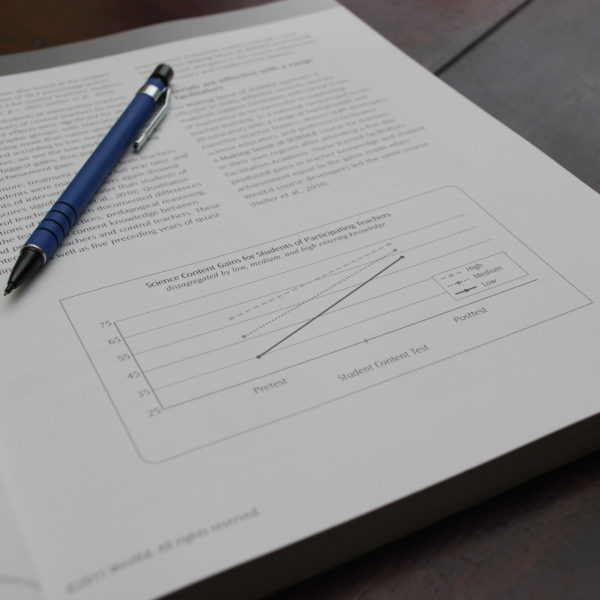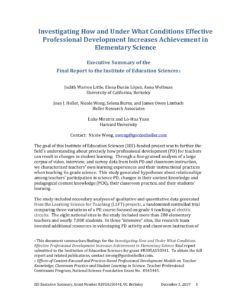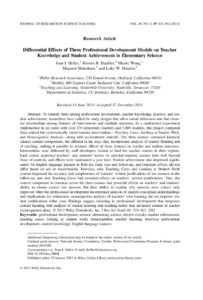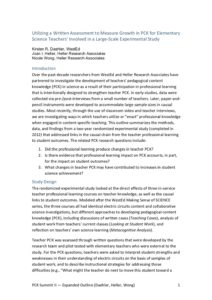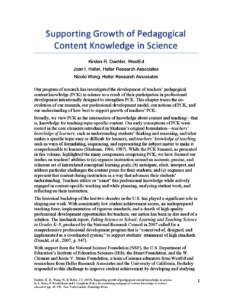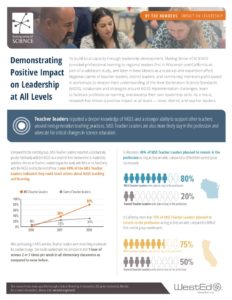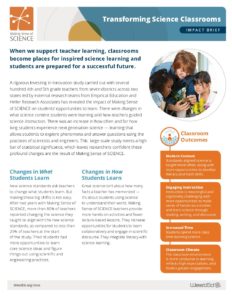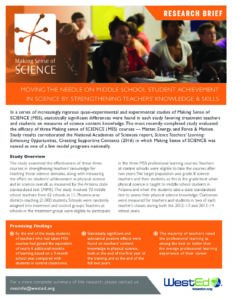MSS professional learning is based on nearly 20 years of large-scale studies that offer compelling evidence that our approach strengthens the knowledge and skills of teachers and leaders across the US.
Making Sense of SCIENCE Logic Model
The MSS project continues to study the interconnected relationships between our teacher and leader professional learning, changes in practice, schools, and classrooms, and ultimately in student impact.
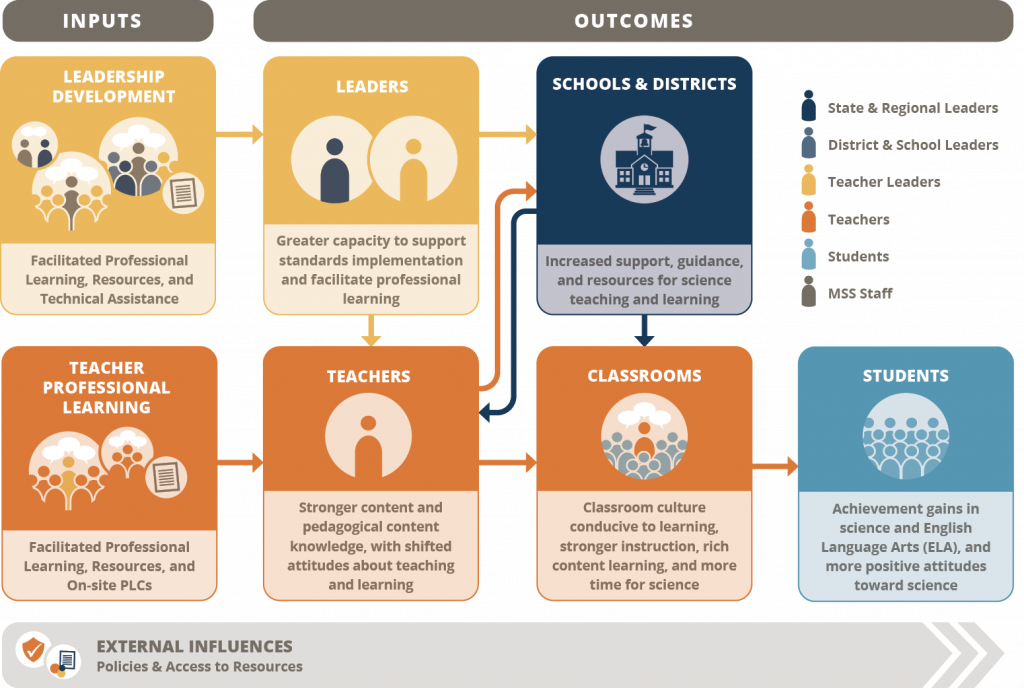
MSS Logic Model
The purpose of this figure is to describe the Making Sense of SCIENCE program by showing the relationship between the program inputs and anticipated outcomes. The figure is a logic model displayed as a flow chart with labeled boxes linked by multidirectional arrows. Each box contains representative images of people and products as well as a short description. At each step in the diagram, arrows point forward to one or more boxes and back to the previous box or boxes. The description below first outlines the flow of inputs to anticipated outcomes then describes each box’s content. Under the entire flow chart, there is a cross-sectional arrow titled ‘External Influences’. And to the side,
there is a key for the different representations of people inside the boxes. The figure begins with the program inputs and points to anticipated outcomes. There are two primary inputs: Leadership Development and Teacher Professional Learning. From the input titled ‘Leadership and Development,’ one forward arrow points to the outcome titled ‘Leaders.’ From the outcome titled ‘Leaders,’ one forward arrow points to the outcome titled ‘Schools and Districts’ and one downward arrow points to the outcome titled ‘Teachers.’ From the input titled ‘Teacher Professional Learning’, one forward arrow points to an outcome titled ‘Teachers’. From the outcome titled ‘Teachers’, one forward arrow points to the outcome titled ‘Classrooms’ and one upward arrow points to the outcome titled ‘Schools and Districts’… From the outcome titled ‘Classrooms’, one forward arrow points to an outcome titled ‘Students’. Each of the color-coded boxes contains a small iconic image and abrief description.
The input titled ‘Leadership Development’ is yellow and shows various groupings of teachers, administrators, and facilitators engaged in professional learning, technical assistance, and coaching. There is also a small icon representing the professional learning materials used. It is described as ‘Facilitated professional learning, resources and technical assistance.
The input titled ‘ Teacher Professional Learning’ is in orange, and shows various groupings of teachers and facilitators engaged in professional learning. There is also a small icon representing the professional learning materials used. It is described as ‘Facilitated professional learning, resources and on-site PLCs.’
The outcome titled ‘Teachers’ is in orange, and shows an icon representing a teacher. It is described as ‘Stronger content and pedagogical content knowledge, with shifted attitudes about teaching and learning.’
The outcome titled ‘Classrooms’ is in orange, and shows an icon representing students and a teacher engaged in classroom dialogue. It is described as ‘Classroom culture conducive to learning, stronger instruction, rich content learning, and more time for science’.
The outcome titled ‘Schools and Districts’ is in dark blue, and shows an icon representing a school. It is described as ‘Increased support, guidance and resources for science teaching and learning.’
The outcome titled ‘Students’ is in light blue, and shows an icon representing students. It is described as ‘Achievement gains in science and English Language Arts (ELA), and more positive attitudes towards science’.
The cross-sectional arrow titled ‘External Influences’ is in grey, and is described as ‘Policies and access to resources’.
Report Library
Transforming Science Classrooms
MSS teacher professional learning affects students’ opportunities to learn by supporting teachers in changing what they teach, and how they teach it.
Investigating How and Under What Conditions Effective Professional Development Increases Achievement in Elementary Science
- Executive Summary
Teacher participation in just 24 hours of MSS science content PD resulted in statistically- significant improvements in student learning outcomes. Additionally, analysis of classroom video showed statistically-significant differences in student cognitive engagement, student engagement in scientific sense-making practices, and teacher elicitation of and attention to student thinking.
Differential Effects of Three Professional Development Models on Teacher Knowledge and Student Achievement in Elementary Science
- Research Article
Teacher participation in just 24 hours of MSS PD resulted in statistically significant gains in teacher and student content knowledge. Additionally, teacher content knowledge gains were maintained 1 year later as well as gains in that year’s student content knowledge. Student gains were consistent for ELLs and did not differ based on sex or race/ethnicity.
Utilizing a Written Assessment to Measure Growth in PCK for Elementary Science Teachers’ Involved in a Large-Scale Experimental Study
- Conference Paper
Using classroom observation data to measure teacher enacted PCK is costly and time-consuming. Using written assessments can be an effective alternative.
Supporting Growth Of Pedagogical Content Knowledge In Science
- Book Chapter
Making Sense of SCIENCE professional development is intentionally designed to strengthen teachers Pedagogical Content Knowledge.
Demonstrating Positive Impact on Leadership at All Levels
- Impact Brief
MSS teacher leaders develop a deep familiarity with Next Generation Science Standards and make plans to stay in the teaching profession more than their colleagues. Through leadership professional learning, they are able to support other teachers and advocate for increased science support at their sites.
Transforming Science Classrooms
- Impact Brief
MSS teacher professional learning affects students’ opportunities to learn by supporting teachers in changing what they teach, and how they teach it.
Moving the Needle on Middle School Student Achievement in Science by strengthening Teachers’ Knowledge and Skills
- Impact Brief
Students whose teachers participated in three, 5-day physical science courses, and used school-year formative assessment supports, gained an equivalent of nearly 6 months of science learning as measured by the Arizona state standardized test.
Ready to bring proven professional learning to your site?
Our speciality is customizing professional learning and technical assistance to meet the needs of our partners. Let us help you innovate.
Partner With Us